Measurement and Analysis of Atomic Hydrogen and Diatomic Molecular AlO, C2, CN, and TiO Spectra Following Laser-induced Optical Breakdown
Summary
Time-resolved atomic and diatomic molecular species are measured using LIBS. The spectra are collected at various time delays following the generation of optical breakdown plasma with Nd:YAG laser radiation and are analyzed to infer electron density and temperature.
Abstract
In this work, we present time-resolved measurements of atomic and diatomic spectra following laser-induced optical breakdown. A typical LIBS arrangement is used. Here we operate a Nd:YAG laser at a frequency of 10 Hz at the fundamental wavelength of 1,064 nm. The 14 nsec pulses with anenergy of 190 mJ/pulse are focused to a 50 µm spot size to generate a plasma from optical breakdown or laser ablation in air. The microplasma is imaged onto the entrance slit of a 0.6 m spectrometer, and spectra are recorded using an 1,800 grooves/mm grating an intensified linear diode array and optical multichannel analyzer (OMA) or an ICCD. Of interest are Stark-broadened atomic lines of the hydrogen Balmer series to infer electron density. We also elaborate on temperature measurements from diatomic emission spectra of aluminum monoxide (AlO), carbon (C2), cyanogen (CN), and titanium monoxide (TiO).
The experimental procedures include wavelength and sensitivity calibrations. Analysis of the recorded molecular spectra is accomplished by the fitting of data with tabulated line strengths. Furthermore, Monte-Carlo type simulations are performed to estimate the error margins. Time-resolved measurements are essential for the transient plasma commonly encountered in LIBS.
Introduction
Laser-induced breakdown spectroscopy (LIBS) techniques1-5 have applications in atomic6-12 and molecular studies of plasma13-20 generated with laser radiation. Time-resolved spectroscopy is essential for determination of the transient characteristics of the plasma. Temperature and electron density, to name but two plasma parameters, can be measured provided a reasonable theoretical model of the plasma breakdown is available. Separation of free-electron radiation from atomic and molecular emissions allows us to accurately explore transient phenomena. By focusing on a specific temporal window, one can “freeze” plasma decay and thereby obtain accurate spectroscopic fingerprints. LIBS has a variety of applications and recently interest in LIBS-diagnostics shows a considerable increase when measured by the number of researchers publishing in the field. Pico- and femtosecond generated microplasma is of ongoing research interest, however, historically experimental LIBS arrangements utilize nanosecond laser radiation.
Figure 1 displays a typical experimental arrangement for laser-induced breakdown spectroscopy. For this protocol, the functional breakdown energy for the initial beam is on the order of 75 mJ pulse, at the infrared wavelength of 1,064 nm. This pulse energy can be adjusted as needed. The plasma is dispersed by the spectrometer and measured with an intensified linear diode array and OMA or, alternatively, imaged onto an Intensified 2-dimensional Charge Coupled Device (ICCD). Figure 2 illustrates the timing diagram for time-resolved experiments: synchronization of pulsed laser radiation with readout, laser pulse trigger, laser fire, and gate-open delay.
Successful time-resolved spectroscopy requires various calibration procedures. These procedures include wavelength calibration, background correction, and most importantly, sensitivity correction of the detector. Sensitivity corrected data are important for the comparison of measured and modeled spectra. For an increase of signal-to-noise ratio, multiple laser-induced breakdown events are recorded.
Protocol
1. Optical System Setup
- Place a beam splitter at the exit of the laser, allowing the 1,064 nm wavelength light to pass through and to reflect all other transient laser radiation into a beam dump.
- Place a high-speed PIN photodiode detector to record a portion of the laser radiation reflected off the beam splitter. Connect this detector to the oscilloscope with coaxial cable to monitor the optical pulse with respect to triggering by the function generator and occurrence of the Q-switching in the Nd:YAG laser device.
- Align three IR reflective mirrors to position the beam parallel to the slit of the spectrometer.
- Position a lens above translational stage to focus the beam in order to generate optical breakdown plasma parallel to the spectrometer slit. Align two quartz lenses for the purpose of imaging the plasma onto the slit. The two focusing lenses optimally match the spectrometer design, meaning the final lens has an aperture to accomplish a f# identical with the f# of the spectrometer's internal optics.
- For measurements above 380 nm, position a cut-on filter between the two lenses for the purpose of blocking radiation below 380 nm. The cut-on filter suppresses possible UV contributions (due to 2nd order of grating) to the measured spectra.
2. Data Acquisition Setup
- Connect a wave-form function generator providing a triangular wave at 50 Hz to a custom built divide-by-five circuit to obtain 10 Hz. The optical multichannel analyzer (OMA) is operated at 50 Hz and the flash lamps of the Nd:YAG laser are synchronously operated at 10 Hz. One can use an ICCD in place of the OMA, operating synchronously at the rate of the pulsed laser radiation as well.
- Connect one of the outputs of the custom built divide-by-five circuit to a digital delay generator. Use one output to synchronize the Nd:YAG flash lamps and another output to control the triggers of the linear diode array intensifier and optical multichannel analyzer. Again, instead of the intensified linear diode array and OMA one can use an ICCD.
- Relay the adjustable trigger output of the laser device to an oscilloscope and to a pulse generator. The oscilloscope will be used to monitor when the pulsed laser radiation will be available for optical breakdown generation or laser ablation.
- Connect the high voltage output of the digital pulse generator to the intensified linear diode array.
- Connect the other output of the pulse generator to the oscilloscope.
- Connect the intensified linear diode array output to the OMA.
3. Synchronization and Measurement
- Set the wave-form function generator to output a triangle pulse operating at 50±1 Hz. This function generator provides the master frequency. A custom built divide-by-five circuit and a digital delay generator are used for accurate synchronization.
- Initiate water cooling system and power supply for laser device. Activate laser.
- Determine the time for laser radiation to travel from the exit aperture of the Nd:YAG laser to the area in front of the spectrometer slit as follows: Measure the distance of the light path and compute the transit time using the speed-of-light. Account for this transit time in setting the gate delay time in next step.
- On the digital pulse generator, set the gate width for the measurement and the delay time from optical breakdown or laser ablation pulse, and use the oscilloscope to monitor the delay time. The delay time will determine how long to wait for data collection after breakdown occurs. The gate width determines how long the diode array is exposed to plasma radiation.
- Generate optical breakdown in air and/or place a sample on the translational stage such that ablation will occur. Image the microplasma onto the spectrometer slit.
- Begin measurements and record data with the intensified linear diode array and optical multichannel analyzer (or with an ICCD).
4. Wavelength Calibration
- Record spectra from standard calibration lamps: neon, mercury, and hydrogen lamps. Use the experimental arrangement with lamps put at the place where plasma was generated.
- Using the known wavelengths from lamps, perform a linear or cubic fit to obtain the pixel-wavelength correspondence. The purpose of an accurate calibration is to correct for nonlinearities that are usually associated with measurement of spectra.
- Repeat calibrations for H, C2, CN, and TiO spectral regions of interest.
5. Intensity Calibration
- Turn on a tungsten calibration lamp and wait for it to warm up.
- Use an optical pyrometer to measure the temperature of the active lamp.
- Use the experimental arrangement to record the spectrum of the active lamp.
- Compute a blackbody curve from Plank's radiation law using the measured temperature as an input parameter.
- Fit the computed curve to the spectrum of the active lamp. Determine the factors by which the recorded intensities from the computed curve. Apply those factors to correct recorded spectra for wavelength-dependent sensitivity of the detector.
- Repeat this for each region the spectrometer was used.
6. Data Transfer
- Prepare medium for file transfers.
- For each data measurement, record it onto the medium.
- Take this medium and upload the files on it to a work computer.
7. File Preparation
- For each file, parse it into sections, one containing recorded data, and the others specifying starting wavelength and average wavelength shift per data point.
- Use these sections to create a new file to match wavelengths with recorded data.
8. Diatomic Molecular Analysis
- Select the wavelength file and corresponding line strength file.
- Select the baseline offset.
- Set whether the offset is constant, linear, or quadratic.
- Set the corresponding coefficients to either fixed or variable values.
- Set the resolution and temperature, both of which can be either fixed or varied.
- Set the tolerance of fit for the synthetic spectra to be fit to the measured spectra.
- Fit the computed to the experimental spectra using a Nelder-Mead algorithm.
- Using the best fitting parameters of the computed spectra for each measurement, infer the microplasma parameters observed at the various time delays and gate widths used.
Representative Results
LIBS utilizes pulsed laser radiation to sufficiently ionize a sample to form plasma. Laser-induced breakdown of gaseous substances will create plasma that is centered about the focal region of the excitation beam, while laser ablation on solid surfaces will produce plasma above the sample's surface. The plasma is generated by focusing the optical radiation on the order of 100 GW/cm2 for nanosecond breakdown pulses. To produce laser ablation plasma, typically 1 GW/cm2 is more than sufficient. The induced plasma radiation is dispersed by a spectrometer. Only for specific delay times from optical breakdown, atomic and diatomic spectra are well developed. Figures 3-7 illustrate representative results.
Early in the plasma decay, atomic lines evolve as the free electron background radiation diminishes. Subsequently, primarily due to recombination, molecular spectra can be recorded. In the experiments, the intensifier of the linear diode array must be accurately triggered. Alternatively, an ICCD must be accurately triggered as well. This triggering (or timing) must occur consistently, so that acquired data are composed from contributions at an accurate delay time from the breakdown event. Subsequently, the OMA digitizes the signal from the intensified linear diode array and stores data. For an ICCD, timing is equally important and data is stored similarly. In the experiments with the intensified linear diode array, the OMA records only the first of five scans, the other four remaining scans are redundant but consecutive scans are ignored. Figure 2 illustrates how the representative intensified linear diode array results are obtained.
For investigations regarding atomic species, atomic lines are studied with respect to the spectral lines' shape and width. The measured atomic line shapes and widths are compared to corresponding theoretical models. This comparison allows one to determine the electron density in the observed region of the plasma. In investigations of diatomic molecular spectra, usually many spectral lines contribute to several molecular bands. For each measurement, the spectra are analyzed with respect to the shapes, widths, and relative intensities of the individual lines contained in the molecular bands. Comparison of the measured and computed spectra utilizes line strengths derived from diatomic quantum theory together with high-resolution spectral data that are available in the literature. This comparison allows one to infer an excitation temperature of the diatomic molecules in the observed region of the plasma. The fitting is accomplished with a Nelder-Mead algorithm, allowing one to perform a multiparameter, nonlinear fit of computed spectra to the measured spectra. In the following, results are presented for selected experiments that address diatomic molecular and atomic line spectra.
Figure 3 illustrates measured and fitted TiO spectra. When imaging certain areas of the TiO plume, the fitted temperature versus time shows a local minimum. This minimum is possibly due to combustion.
The primary analysis objective for the hydrogen spectra is to determine the electron density and temperature from the time-resolved spectra for the hydrogen-alpha and hydrogen-beta lines. Figure 4 shows hydrogen alpha profiles recorded along the slit height. Laboratory air species such as nitrogen and oxygen cause the hydrogen alpha lines to emerge after the initial optical breakdown event. The evolution of the hydrogen-alpha line is investigated for time delays of 0.4 µsec up to 30 µsec after the optical breakdown. The hydrogen alpha figure also indicates a higher electron density in the center of the plasma, displayed in the figure near the middle of the indicated slit axis.
The C2 molecule shows that its lowest rotational levels are sensitive to temperature variation, and higher rotational levels are sensitive to the surrounding gas density and radiation field. Figure 5 displays a typical measured and fitted result following laser ablation in air. Analysis of the carbon Swan spectra includes studying the formation of C2 due to recombination in an effort to understand the formation of C2 and CN following laser ablation of graphene. Figure 6 shows recorded and fitted CN spectra, and the figure also shows excellent agreement with theory. The experimental spectra match well with the computed spectra, and convincing agreement can be seen in the trailing ends and band heads. Like the C2 spectra, the rotation/vibration spectra of aluminum monoxide show well developed molecular bands for the elevated temperature in the decaying laser-induced microplasma. Figure 7 shows measured and fitted AlO spectra. Since AlO is an early product in the combustion of aluminum, spectroscopic studies AlO has applications in aluminum combustion studies, primarily for temperature determination.
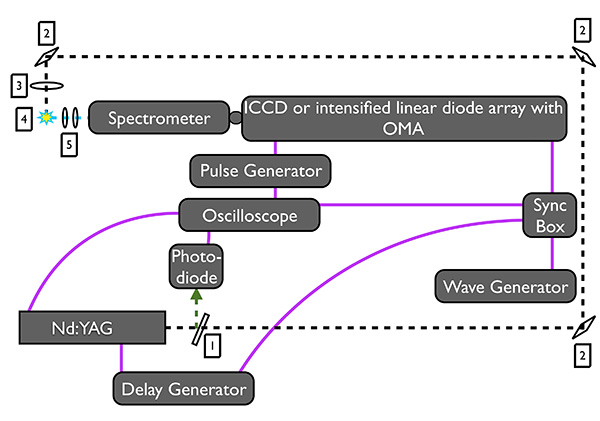
Figure 1. The schematic arrangement shows the following experimental components: (1) Beam splitter to deflect a small portion of 1,064 nm laser radiation; (2) Infrared reflective mirrors to vertically align the beam in front of the spectrometer; (3) lens to focus the beam to a tight spot for optical breakdown; (4) the star symbolizes optical breakdown or laser ablation plasma; and (5) two lenses to match the focusing optics of the spectrometer. The sync box, wave, and delay generator accomplish electronic synchronization of the laser and intensified linear diode array and OMA (or ICCD) operating frequencies. The photodiode, pulse generator, and oscilloscope allow one to accurately control and monitor the measurement window for LIBS. Click here to view larger image.
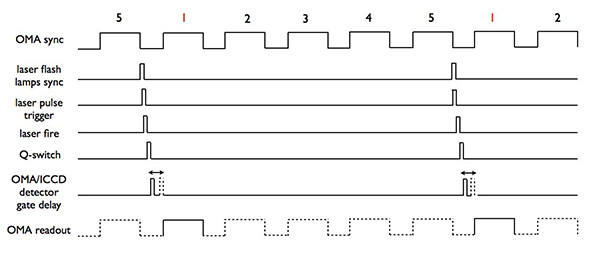
Figure 2. Timing diagram for time-resolved LIBS measurements. OMA sync and laser flash lamp sync are provided by a wave and delay generator and custom-built circuitry. Laser pulse trigger and fire pulse is provided by the Nd:YAG laser device together with Q-switch delay control. An extra pretrigger, electronic pulse (not shown) is also provided by the Nd:YAG laser manufacturer. This pretrigger allows us to accurately and efficiently control the detector gate delay of the OMA/ICCD system. The OMA readout occurs subsequent to exposure of the diode array, including 4 subsequent but ignored readout scans. For single pulse experiments, individual OMA readouts are stored separately in memory. For 100-scan average measurements, the OMA readout scans are added and then stored. Click here to view larger image.
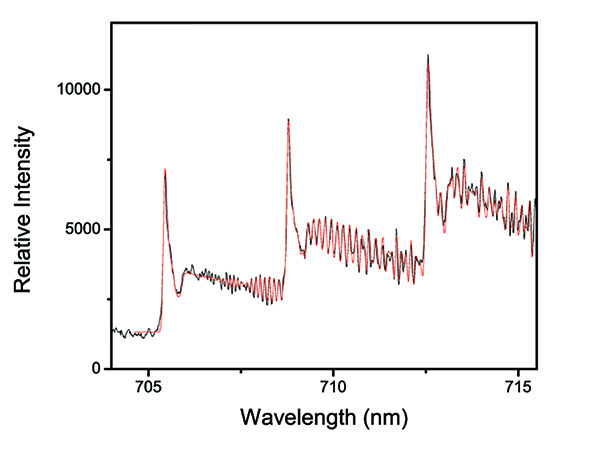
Figure 3. The measured and synthetic emission spectra show the TiO A3φ→X3Δ Δv = 0 transition. The measured data was collected with the intensified linear diode array at delay time of tdelay= 95 µsec with a gate width of 2 µsec. The measured spectra is fit with computed spectra corresponding to a spectral resolution of FWHM = 0.09 nm and an inferred temperature T = 3,300 K. Click here to view larger image.
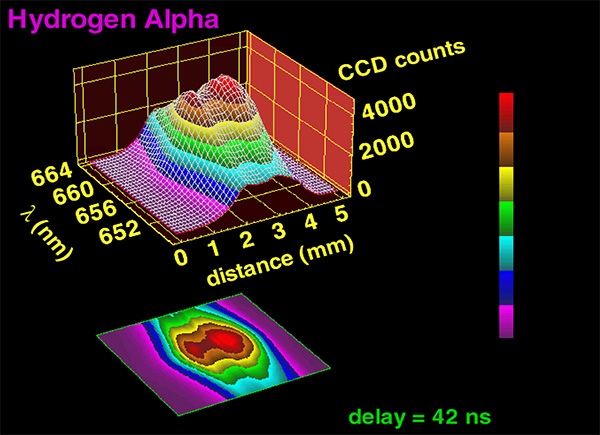
Figure 4. Hydrogen Balmer alpha line recorded in 1.07 x 105 Pa gaseous hydrogen. The emissions of 1,000 consecutive optical breakdown events were dispersed with the spectrometer and collected with an ICCD, 0.042 µsec from optical breakdown and spatially resolved along the spectrometer slit-height. For this time delay, the maximum electron number density is 0.32 x 1025 electrons/m3, and the maximum Hα red shift amounts to 1.2 nm. Individual spectra of hydrogen alpha and beta lines are illustrated for example in Parigger6. Recording of hydrogen alpha and beta lines following breakdown in air is part of the documentary video of this JoVE publication. Click here to view larger image.
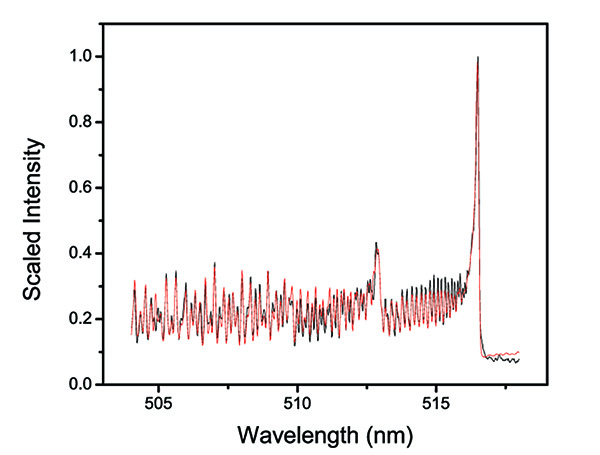
Figure 5. The C2 Swan spectra were collected with the intensified linear diode array at a time delay tdelay = 20 µsec using a gate width of 1 µsec. The measured spectrum was fit with computed spectra for a FWHM spectral resolution of 0.07 nm and a temperature of T = 5,600 K is inferred. Click here to view larger image.
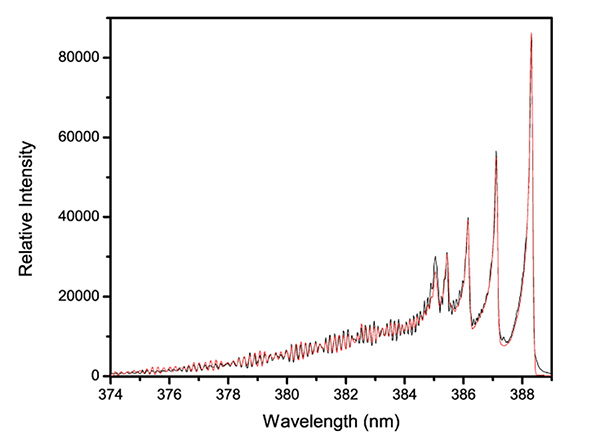
Figure 6. The CN B2ε+→X2ε+ violet transition was recorded with the intensified linear diode array at time delay of tdelay = 70 µsec with a gate width of 4 µsec. The measured spectrum is fit with computed spectra using a FWHM spectral resolution of 0.09 nm. The inferred temperature is T = 6,600 K. Click here to view larger image.
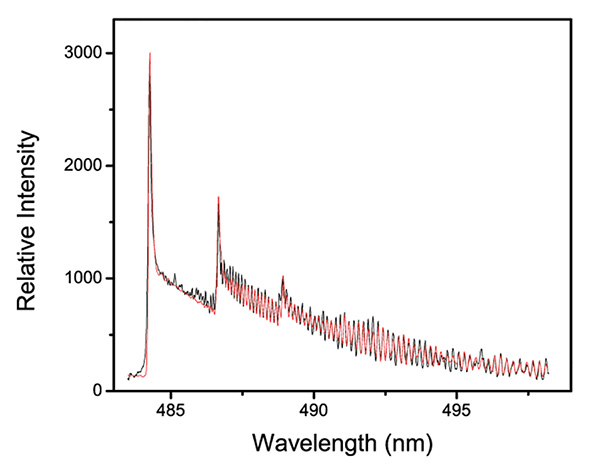
Figure 7. The AlO B 2ε+→X2ε+ diatomic spectra for the Δ = 0 transitions were collected with the intensified linear diode array at a time delay of tdelayn= 45 µsec using a gate width of 5 µsec. The fitted spectra are computed using a FWHM spectral resolution of 0.09 nm. The inferred temperature amounts to T = 3,900 K. Click here to view larger image.
Discussion
The time resolved measurement protocol and representative results are further discussed here. It is important to synchronize the laser pulses, generated at a rate of 10 Hz, with the 50 Hz operating frequency of the intensified linear diode array and OMA (or ICCD). Furthermore, accurate timing of laser pulses and opening of the gate of the intensified linear diode array (or alternatively ICCD) is essential. The wave generator, indicated in the experimental schematic, is used to synchronize the laser pulses and intensified linear diode array readout that is accomplished with the optical multichannel analyzer. A pulse generator is utilized to adjust the time delay for the measurements.
Temporal overlap of the laser pulse centered in the intensifier gate-open window corresponds to the initial zero time delay, tdelay = 0. In the effort to determine the temporal evolution of the emission spectra, the time delay from optical breakdown is varied. For example, the hydrogen alpha line cannot be seen in air breakdown events until 0.4 µsec after the initial plasma is generated. Measurements of emission spectra also require wavelength and intensity calibrations. These calibrations are necessary for analysis.
For LIBS measurements, observing plasma evolution by ablating metallic samples such as Ti, there are often many atomic lines present in the wavelength range of the diatomic transitions of interest. These lines can be persistent in the gathered spectra, even at later delay times. However, some of these lines occur in second order of the dispersive grating in the spectrometer. The use of a low-pass filter is beneficial to block such second-order contributions.
While the procedures of data collection are important, the methods used for fitting hold an equal merit. Temperature inferences are accomplished by fitting synthetic spectra of varying microplasma parameters to the gathered spectra utilizing a Nelder-Mead algorithm. The reliability of this procedure is greatly enhanced when the background of the spectra can be accurately identified. In this context, the term background refers to everything in the recorded spectra except for the atomic or molecular transition of interest. To quantify the effect of this background, the recorded data are investigated by analyzing signal to noise ratios with respect to their effect on the inferred temperature inferred from diatomic molecular spectra. This investigation is facilitated by the use of Monte Carlo type simulations.
The significance of the short-gate time-resolved measurement certainly includes the ability to capture highly excited atomic and molecular spectra. For the hydrogen Balmer alpha line, use of 6 nsec gate resulted in successful determination of electron density up to almost 1025/m3. For diatomic molecular emission spectra, excitation temperatures in excess of 6,000 K is typical for LIBS with nanosecond Nd:YAG laser radiation. Without an intensifier, measurements would constitute an average over time recorded during the transient events. The illustrated snapshots in time allow one to investigate generation and decay of laser induced plasma. One can, in principle, record highly excited molecular spectra slightly displaced from the bright laser induced plasma, such as in the study of plasma torches. However, one would not capture the early dynamics of the plasma decay, including measurements of highly excited atomic species.
Future applications of laboratory measurement of atomic and molecular spectra following laser-induced optical breakdown continue to be of both fundamental and application-oriented interest. Measurements of atomic line widths early in the plasma decay allow one to determine the plasma conditions/parameters. Ongoing research efforts include accurate modeling of Stark broadening and/or line shapes. Molecular spectra, along with accurate knowledge of the transitions of interest, show increased numbers of applications especially in areas of identification, characterization, and determination of, for example, explosives, combustion plumes, stellar atmospheres, or chemical composition. The methods and applications of time-resolved spectroscopy are important in establishing the dynamics following generation of plasma with laser radiation. These dynamics include plasma oscillations, changes of line shapes due to collisions, emissions due recombination radiation and/or combustion processes. Temporal separation of the processes that occur following optical breakdown is important for determining the transient phenomena. We understand that the initial LIBS application of elemental analysis due to radiation from atomic species will be strongly augmented by measurements of molecular species that includes analysis of radiation from different, individual atomic isotopes and isotopomers.
Disclosures
The authors have nothing to disclose.
Acknowledgements
The authors thank Mr. J. O. Hornkohl for interest and discussion on computation of diatomic molecular line strengths. This work is in part supported by the Center for Laser Applications at the University of Tennessee Space Institute.
Materials
| Custom Box | UTSI | None | Signal divider and conditioner. An oscilloscope can be used in place of this |
| Four Channel Digital Delay/Pulse Generator | Stanford Research Systems, Inc. | Model DG535 | Companies: Tequipment, diyAudio |
| Four Channel Color Digital Phosphor Oscilloscope | Tektronix | TDS 3054 | 500 MHz – 5 GS/sec, Companies: Amazon, Tektronix, Fluke, Agilent Technologies, Pico Technology |
| Wavetek FG3C Function Generator | Wavetek | FG3C | Companies: Tequipment, Stanford Research Systems, BK Precision |
| Nd:YAG Laser | Quanta-Ray | DCR-2A(10) PS | Laser radiation, Class IV. Companies: Lambda Photometrics, Continuum, Ellipse, Newport |
| Si Biased Detector | Thorlabs | DET10A/M | 200-1,100 nm, with ND10A reflective filter. Companies: Canberra, Edmund Optics |
| Nd:YAG Laser Line Mirror, 1,064 nm | Thorlabs | NB1-K13 | Companies: Edmund Optics, Newport |
| 1 in Fused Silica Bi-Convex Lens, uncoated | Newport | SBX031 | Companies: Edmund Optics, Thorlabs |
| 2 in Fused Silica Plano-Convex lens, uncoated | Newport | SPX049 | Convex lens, f/4. Companies: Edmund Optics, Thorlabs |
| Spectrograph | Instruments S.A. division Jobin-Yvon | HR 640 | Companies: Andor, Newport, Horiba |
| Manual and electronic controller for Spectrograph | Instruments S.A. division Jobin-Yvon | Model 980028 | Manual and electronic controller for Spectrograph |
| Mega 4000 | Mega | Model 129709 | Computer interface for Spectrograph |
| Gateway 2000 Crystal Scan 1024 monitor | Gateway | PMV14AC | Monitor for computer interface |
| 20 MHz Oscilloscope | BK Precision | Model 2125 | Companies: Amazon, Tektronix, Fluke, Agilent Technologies, Pico Technology |
| 6040 Universal Pulse Generator | Berkeley Nucleonics Corporation | Model 6040 | Companies: Agilent Technologies, Tektronix, Quantum Composers |
| Separate component to 6040 Universal Pulse Generator | Berkeley Nucleonics Corporation | Model 202 H | Separate component to 6040 Universal Pulse Generator |
| ICCD Camera | EG&G Parc | Model 46113 | Companies: Andor, Standford Computer Optics, LaVision, Hamamatsu |
| OMA III | EG&G Parc | Model 1460 | Spectral data acquisition and analysis. Unit discontinued, replaced by software installed on computers. |
References
- Miziolek, A. W., Palleschi, V., Schechter, I. . Laser Induced Breakdown Spectroscopy. , (2006).
- Cremers, D. E., Radziemski, L. J. . Handbook of laser-induced Breakdown Spectroscopy. , (2006).
- Singh, J. P., Thakur, S. N. . Laser Induced Breakdown Spectroscopy. , (2007).
- Hahn, D. W., Omenetto, N. Laser-induced breakdown spectroscopy (LIBS), Part I: review of basic diagnostics and plasma-particle iterations: still-challenging issues within the analytical plasma community. Appl. Spectrosc. 64, (2010).
- Hahn, D. W., Omenetto, N. Laser-induced breakdown spectroscopy (LIBS), Part II: review of instrumental and methodological approaches to material analysis and applications to different fields. Appl. Spectrosc. 66, 347 (2012).
- Parigger, C. G. Atomic and molecular emissions in laser-induced breakdown spectroscopy. Spectrochim. Acta Part B. 79, 4-16 (2013).
- Konjević, N., Lesage, A., Fuhr, J. R., Wiese, W. L. Experimental Stark widths and shifts for spectral lines of neutral and ionized atoms. J. Phys. Chem. Ref. Data. 31, 819-927 (2002).
- Oks, E. Stark broadening of hydrogen and hydrogen-like spectral lines in plasmas: the physical insight. Alpha Science Int. , (2006).
- Parigger, C. G., Dackman, M., Hornkohl, J. O. Time-resolved spectroscopy measurements of hydrogen-alpha, -beta, and -gamma emissions. Appl. Opt. 47, (2008).
- Parigger, C. G., Oks, E. Hydrogen Balmer series spectroscopy in laser-induced breakdown plasmas. Int. Rev. Atom. Mol. Phys. 1, 13-23 (2010).
- Lucena, A. D., Tobaria, L. M., Laserna, J. J. New challenges and insights in the detection and spectral identification of organic explosives by laser induced breakdown spectroscopy. Spectrochim. Acta Part B. 66 (1), 12-20 (2011).
- Swafford, L. D., Parigger, C. G. Measurement of hydrogen Balmer Series lines following laser-induced optical breakdown in laboratory air. Accepted, Int. Rev. Atom. Mol. Phys. 4 (1), (2013).
- Hornkohl, J. O., Nemes, L., Parigger, C. G., Nemes, L., Irle, S. Spectroscopy of Carbon Containing Diatomic Molecules. Spectroscopy, Dynamics and Molecular Theory of Carbon Plasmas and Vapor. , 113-165 (2011).
- Parigger, C., Hornkohl, J. O. Diatomic molecular spectroscopy with standard and anomalous commutators. Int. Rev. Atom. Mol. Phys. 1, 25-43 (2010).
- Parigger, C. G., Hornkohl, J. O. Computation of AlO emission spectra. Spectrochim. Acta Part A. 81, 404-411 (2011).
- Hermann, J., Peronne, A., Dutouquet, C. Analysis of the TiO-γ System for temperature measurements in laser-induced plasma. J. Phys. B: At. Mol. Opt. Phys. 34, 153-164 (2001).
- Woods, A. C., Parigger, C. G., Hornkohl, J. O. Measurements and analysis of titanium monoxide spectra in laser-induced plasma. Opt. Lett. 37, 5139-5141 (2012).
- Witte, M. J., Parigger, C. G. Measurement and analysis of carbon Swan spectra following laser-induced optical breakdown in air. Accepted, Int. Rev. Atom. Mol. Phys. 4 (1), (2013).
- Surmick, D. M., Parigger, C. G., Woods, A. C., Donaldson, A. B., Height, J. L., Gill, W. Analysis of emission Spectra of Aluminum Monoxide in a Solid Propellant Flame. Int. Rev. Atom. Mol. Phys. 3 (2), 2-137 (2012).
- Woods, A. C., Parigger, C. G. Time-resolved Temperature Inferences Utilizing the TiO A3φ→X3Δ Band in Laser-induced Plasma. Int. Rev. Atom. Mol. Phys. 3 (2), 103-111 (2012).

